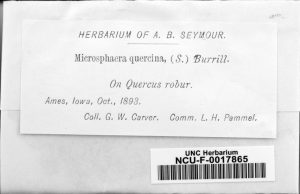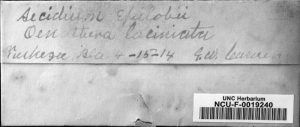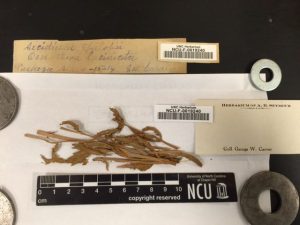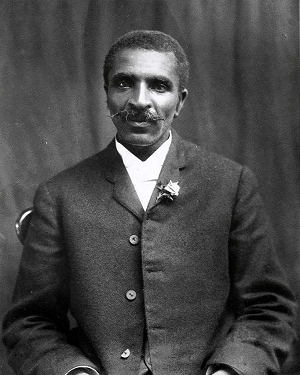(1860’s – 5 January 1943)
Listen to Well Said: George Washington Carver’s fungal specimens, a podcast produced in 2017 by University of North Carolina at Chapel Hill.
The University of North Carolina at Chapel Hill Herbarium (NCU) has 18 fungal specimens collected by George Washington Carver. About half of the specimens were collected in Story County, Iowa while he was a graduate student at Iowa State Agricultural College (now Iowa State University) in Ames, Iowa, and the other half were collected from Macon County, Alabama while Carver was on the faculty of the Tuskegee Institute (now Tuskegee University) in the city of Tuskegee, Alabama. As we continue to catalog our mycological collection, it is possible that more specimens collected by Carver will be found.

How Carver’s specimens came to the mycological collection at Chapel Hill is unclear. They are part of the Arthur Bliss Seymour microfungi collections which may have been given to the Herbarium by Frank Conkling Seymour, Arthur’s son.
George Washington Carver’s mycological collections are numerous and curated by herbaria across North America. In addition to NCU, Carver’s specimens can be found in herbaria at Cornell University (CUP), the Field Museum (F), the United States National Fungus Collection (BPI), the University of Florida (FLAS), and the University of Wisconsin (WIS).
Carver’s parents, George and Mary, were enslaved by Moses Carver in Newton County, Missouri. “To further his quest for learning, [Carver] traveled to Kansas, hoping to expand his educational opportunities. He graduated from high school [in Minneapolis, Kansas] but was denied enrollment at Highland College [in Kansas] after he arrived and they realized he was African American… He was welcomed to Simpson College (Indianola, Iowa) in 1890, where his talent for art and botany were apparent. His art teacher, Etta Budd, was concerned about Carver’s ability to support himself. She encouraged Carver to pursue a career in botany and horticulture through her father, Joseph Budd, Horticulture Department Chair at Iowa Agricultural College (IAC, now Iowa State University) in Ames, Iowa.”(1) Carver entered the Iowa State Agricultural College as an undergraduate student in 1891 (some sources say 1892), and earned his Bachelor of Science in 1894.(1,2) His B.S. thesis, “Plants as Modified by Man,” is available from the University Library Digital Collections. He was the first African American to earn a degree from Iowa State University.(1)
Carver continued at Iowa for his graduate work on plant pathology and mycology with Louis Hermann Pammel (1862-1931), and earned his M. S. in 1896. “[Iowa State University] hired Carver as an assistant botanist on the faculty and he also served as an extension specialist for the college, which was a land grant institution.”(1) Booker T. Washington recruited Carver to head the Tuskegee Institute’s Agriculture Department, and Carver taught at Tuskegee for 47 years.(2)


“During Carver’s time at Tuskegee, cotton was at great risk from the boll weevil. His research also focused on food and industrial uses not only for the peanut, but also for the sweet potato, cotton, clay, corn, soybeans, and pecans. Carver is known as the “father of chemurgy” for his work in converting organic material to industrial uses.”(1)
“New Alabama Fungi” by J. B. Ellis and B. M. Everhart in the Journal of Mycology 8(2): 62-73 list 59 species of fungi “collected in the vicinity of Tuskegee, Alabama, by George W. Carver, Director of the Department of Agriculture and Agricultural Experiment Station at Tuskegee, Ala.”. Included in the list are Colletotrichum carveri E. & E. (“on leaves of tea plant, cult.”) and Metasphaeria carveri E. & E. (“On dead stems of Sesamum orientale, Glycine hispida, Cassia tora and Mucuna utilis“) which were named in honor of the collector.
Carver kept in contact with his graduate advisor, Louis Pammel, over many decades; Iowa State University Library Special Collections & University Archive curates correspondence between the two scientists.(3)
Carver died at age 78 on 5 January 1943 after suffering a fall down a flight of stairs in his home. He is buried on the grounds of Tuskegee University.(1)
- Zanich-Belcher, Tanya. “Carver, George Washington” in Encyclopedia of Science and Technology Communication, vol. 1, pages 115-117. Edited by Susanna Hornig Priest. SAGE Publications, Inc. 2010, Thousand Oaks, California.
- Wikipedia contributors. “George Washington Carver.” Wikipedia, The Free Encyclopedia. Wikipedia, The Free Encyclopedia, 1 Jul. 2020. Web. 8 Jul. 2020.
- George Washington Carver Collection, 1893-ongoing. Iowa State University Library Special Collections & University Archives. http://findingaids.lib.iastate.edu/spcl/arch/rgrp/21-7-2.html
